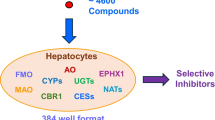Abstract
Two human hepatoma cell lines, KYN-2 and Mz-Hep-1 were characterized in terms of glucuronidation capacity and inducibility of cytochrome P4501A1/1A2 and several UDP-glucuronosyltransferases (UGTs). Cytochrome P4501A1/1A2 activity was measured using 7-ethoxyresorufin and that of UGTs with 16 different substrates. The effects of dimethyl sulfoxide (DMSO), β-narphthoflavone, α-napthoflavone, and rifampicin on these drug-metabolizing enzyne activities were studied. DMSO treatment increased in a dose-dependent manner the ethoxyresorufin O-deethylase (EROD) activity in KYN-2 cells, while an opposite effect was observed in Mz-Hep-1 cells. In KYN-2 cells, EROD was more responsive toward β-naphthoflavone treatment in combination with DMSO. This activity was enhanced in Mz-Hep-1 cells more than 83 times by β-naphthoflavone. The enhancement of EROD activity by DMSO and β-naphthoflavone treatment of KYN-2 cells was abolished by α-naphthoflavove treatment. In Mz-Hep-1, only the inducing effect of β-naphthoflavone was abolished by α-naphthoflavone treatment. Rifampicin treatment of KYN-2 cells reversed both the DMSO and β-naphthoflavone effects on the EROD activity. Glucuronidation of steroids, bile acids, fatty acids and drugs was effective in KYN-2 and Mz-Hep-1 cells. Both 1-naphthol glucuronidation and the level of UGT*6 protein detected by immunoblot and supporting this activity were lowered by DMSO treatment and increased by β-naphthoflavone treatment in KYN-2 cells. In Mz-Hep-1 cells, DMSO and β-naphthoflavone had no effect on 1-naphthol glucuronidation activity. DMSO, β-naphthoflavone and rifampicin also affected the glucuronidation of various substrates supported by different UGT isoforms. These results indicate that KYN-2 and Mz-Hep-1 cells can be used as new in vitro models for the studies of drug metabolism and the regulation of the corresponding enzymes.
Similar content being viewed by others
Abbreviations
- DMSO:
-
dimethyl sulfoxide
- EROD:
-
ethoxyresorufin O-deethylase
- NF:
-
naphthoflavone
- P450:
-
cytochrome P450 (EC 1.14.14.1)
- RIF:
-
rifampicin
- UGT:
-
UDP-glucuronosyltransferase (EC 2.4.1.17).
References
Abid A, Sabolovic N, Batt AM et al. Induction of UDP-glucuronosyltransferases and cytochromes P450 in human hepatocytes. Cell Pharmacol. 1994;1:257–62.
Bradford M. A rapid and sentitive method for quantitation of microgram quantities of protein utilizing the principle of protein-dye binding. Anal Biochem. 1976;72:248–54.
Burchell B, Nebert D, Nelson DR et al. The UDP-glucuronosyltransferases gene superfamily: suggested nomenclature based on evolutionary divergence. DNA Cell Biol. 1991;10:487–94.
Chowdhury NR, Sber MA, Lahiri P et al. Expression of specific UDP-glucuronosyltransferase isoforms in carcinogen-induced preneoplastic rat liver nodules. Hepatology. 1991;13:38–46.
Dippold WG, Dienes HP, Knuth A et al. Hepatocellular carcinoma after thorotrast exposure: establishment of a new cell line (Mz-Hep-1). Hepatology. 1985;6:1112–9.
Dragacci S, Thomassin J, Magdalou J, Souhaili-El-Amri H, Boissel P, Siest G. Properties of human hepatic UDP-glucuronosyltransferases: relationship to the other inducible enzymes in patients with cholestasis. Eur J Clin Pharmacol. 1987;32:485–91.
Dragacci S, Magdalou J, Bagrel D, Roques M, Fournel-Gigleux S, Siest G. Glucuronidation in human hepatoma cell lines and liver microsomes. In: Siest G, Magdalou J, Burchell B, eds. Cellular and molecular aspects of glucuronidation. London-Paris: Colloque INSERM/John Libbey Eurotext;1988;73:249–60.
Ebner T, Burchell B Substrate specificity of two stably expressed human liver UDP-glucuronosyltransferases of UGT1 gene family. Drug Metab Dispos. 1993;21:50–5.
Finley BL, Ashley PJ, Neptune AG, Yost GS. Substrate-selective inductive of rabbit hepatic UDP-glucuronosyltransferase by ethanol and other xenobiotics. Biochem Pharmacol. 1986;35:2875–81.
Fournel-Gigleux S, Sutherland L, Sabolovic N, Butchell B, Siest G. Stable expression of two human UDP-glucuronosyltransferase cDNAs in V79 cell cultures. Mol Pharmacol. 1991;39:177–83.
Gonzales FJ. Cytochrome P450 in humans. In: Schenkman JB, Greim H, eds. Handb Exp Pharm. Cytochrome P450. Berlin: Springer-Verlag; 1993;105:239–57.
Laemmli UK. Cleavage of structural proteins during assembly of head of bacteriophage T4. Nature. 1974;227:680–5.
Lilienblum W, Wali AK, Bock KW. Differential induction of rat liver microsomal UDP-glucuronosyltransferase activities by various inducing agents. Biochem Pharmacol. 1982;36:907–13.
Lindsay CK, Chenery RJ, Hawsworth GM. Primary culture of rat hepatocytes in the presence of dimethyl sulfoxide: a system to investigate the regulation of cytochrome P450 IA. Biochem Pharmacol. 1991;42suppl:17–25.
Mackenzie PI, Rodbourn L, Stranks S. Steroid UDP-glucuronosyltransferases. J Steroid Biochem Mol Biol. 1992;43:1099–105.
Merchant M, Arellano L, Safe S. The mechanism of action of α-naphthoflavone as an inhibitor of 2,3,7, 8-tetrachlorodibenzo-p-dioxin-induced CYP1A1 gene expression. Arch Biochem Biophys. 1990;281:84–9.
Morel F, Beaune P, Ratanasavanh D et al. Expression of cytochrome P-450 enzymes in cultured human hepatocytes. Eur J Biochem. 1990;191:437–44.
Mulder GJ, Coughtrie MWH, Burchell B. Glucuronidation. In: Mulder GJ, ed. Conjugation reactions in drug metabolism. London: Taylor and Francis; 1990:51–105.
Nelson DR, Kamataki T, Waxman DJ et al. The P450 superfamily: update on new sequences, gene mapping, accession numbers, early trial names of enzymes, and nomenclature. DNA Cell Biol. 1993;12:1–51.
Otani G, Abou EL, Makarem MM, Bock KW. UDP-glucuronosyltransferase in perfused rat liver and microsomes: effect of galactosamine and carbon tetrachloride on the glucuronidation of 1-naphthol and bilirubin. Biochem Pharmacol. 1976; 25:1293–7.
Ouzzine M, Pillot T, Fournel-Gigleux S,Magdalou J, Burchell S, Siest G. Expression and role of the human liver UDP-glucuronosyltransferase UGT1*6 analyzed by specific antibodies raised against a hybrid protein produced in Escherichia coli. Arch Biochem Biophys. 1994;310:196–204.
Perrin R, Minn A, Ghersi-Egea JF, Grassiot MC, Siest G. Distribution of cytochrome P450 activities towards alkoxyresorufin derivatives in rat brain regions, subcellular fractions and isolated cerebral microvessels. Biochem Pharmacol. 1990;40:2145–51.
Pritchard M, Fournel-Gigleux S, Siest G, Mackenzie P, Magdalou J. A recombinant phenobarbital-inducible rat liver UDP-glucuronosyltransferase (UGT2B1) stably expressed in V79 cell catalyzes the glucuronidation of morphine, phenols and carboxylic acids. Mol Pharmacol. 1994;45:42–52.
Ritter JK, Sheen YY, Owens I. Cloning and expression of human liver UDP glucuronosyltransferase in COS-1 cells. 3,4-Catecholestrogens and estriol as primary substrates. J Biol Chem. 1990;241:5879–83.
Sato K, Kitahara A, Yin Z et al. Molecular forms of glutathione S-transferase and UDP-glucuronosyltransferase as hepatic preneplastic marker enzymes. Ann New York Acad Sci. 1993;417:213–23.
Yano H, Maruiwa M, Murakami T et al. A new human pleomorphic hepatocellular carcinoma cell line, KYN-2. Acta Pathol Jpn. 1988;38:953–6.
Author information
Authors and Affiliations
Rights and permissions
About this article
Cite this article
Abid, A., Sabolovic, N. & Magdalou, J. Inducibility of ethoxyresorufin deethylase and UDP-glucuronosyltransferase activities in two human hepatocarcinoma cell lines KYN-2 and Mz-Hep-1. Cell Biol Toxicol 12, 115–123 (1996). https://doi.org/10.1007/BF00143361
Accepted:
Issue Date:
DOI: https://doi.org/10.1007/BF00143361




